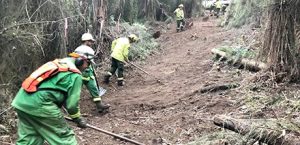I have read the articles on the importance of forest hazard reduction burning in Australia, as a former forester I understand the importance of hazard reduction burning – an individual’s assessment by John O’Donnell.
The wildfires have had a massive impact across Australia, burning 5.2 million hectares in NSW alone, and in many cases extremely hot fires. I understand Australia wildfire area is over 18 million hectares.
Wildfires in 2019/ 20 have had huge impacts on communities, individuals, fire fighters, infrastructure, forest, fauna, water quality, waterways, fish, greenhouse gas generation, air quality and heritage sites.
It is clear to me that all these factors haven’t been adequately considered in an integrated way before to understand the large and broad impacts of wildfires and used as critical base information to progress increased hazard reduction programs. It is understood more than one billion animals have died in the 2019/ 20 wildfires, in NSW alone.
Cool burning has much less impacts on each of the above factors, much less.
On information available to me, the average annual fuel reduction burning in NSW between 2010 to 2019 was 153,291 hectares.
I personally believe the current approach is not adequately focussed on hazard reduction burning across landscapes, using cool season burning. It’s time to urgently review current policies and regulations across Australian states that excludes/restricts/minimises low intensity burning from much of the landscape.
This approach focusses on individuals, a large number of listed threatened flora and fauna species and communities, reduced fire frequencies and inadequate assessment of the consequences of not burning.
This policy environment reinforces the shift towards more widespread high intensity fire regimes in these same areas where fires are restricted.
The current approach to inadequate hazard reduction burning impacts on the health of forests as organic matter builds up, eucalypts decline. Look at the tree crowns and assess the dead branches, sick crowns and epicormic growth where fire hasn’t occurred for long periods.
This issue is of national importance and is poorly understood or in some cases ignored. The time has come to use the research information tabled already in relation to forest fire, health, dieback and fauna and undertake cool burning in the required forests.
I believe hazard reduction minimum area standards for burning need be developed for the states. I suggest that this be no less than 10% of forests per year using the landscape principle.
Cool burning is achieved using a range of principles that vary, including spacing of ignition points, time of day, assessment of aspect, fuel load assessment, soil dryness, wind/ weather and other factors. I suggest that COAG/Commonwealth/State annual review of fuel reduction/ areas hazard reduced in each the states annually and that this be reported in the parliaments and media.
I consider state and federal Governments and landholders should review the legal action risks associated with inadequate hazard reduction burning across southern Australia and design effective hazard reduction burning programs in consultation with agencies, communities and landholders.
Due to past and current inadequate levels of hazard reduction burning programs, the levels of fuel remain very high across many areas of Australia/ NSW and the state has become a tinderbox in many areas. There is already at least one legal action underway, I understand in regards to adequacy of hazard reduction burning.
I suggest that new legislation be enacted by states to implement a Bushfire Hazard Reduction Act, empowering sound an adequate hazard reduction programs across Australia, across all forest sectors, state owned, Council and freehold.
I suggest that this legislation would be independent of the bushfire legislation in each state, although linked and be mirrored under Commonwealth legislation. The legislation would empower legislative hazard reduction programs, nominate minimum annual burning areas, use landscape burning principles, enforce compliance with planned/required burns, include financial and non-financial measures for non-cooperation, remove restrictive environmental constraints/prosecution to sensible landscape hazard reduction burning, set up a protection/insurance system for any escapes and allocate hazard reduction funding arrangements.
I believe that more control regionally is critical, especially in hazard reduction planning. Bushfire Associations/Regional committees in regional areas need to have a greater say in the planning and undertaking of hazard reduction burning at the local level and could be used to increase uptake of hazard reduction burning and reduce bureaucracy as much as is possible.
If we don’t learn from these wildfires and quickly adapt, more very large area, massive, intense wildfires will occur again.
John O’Donnell was a forester with the then NSW Forestry Commission for 11 years and has made submissions to four recent bushfire inquiries on the inadequacy of hazard reduction inquiries.
He holds a Bachelor of Science (Forestry) Hons 1978 from Australian National University. He also holds a Post Graduate Diploma in Agronomy and Farming Systems from the University of Adelaide 1996 and 1997, majoring in environmental issues in agriculture.
He was awarded a Commonwealth Forestry Scholarship in 1976 and 1977, and a North Australia Research Unit Grant in 1977, which included four months study in the NT with CSIRO Division of Forest Research.








